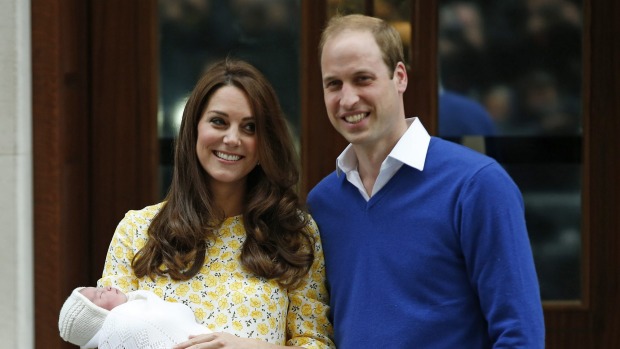With more than 100 years of medical experience between them, the baby princess was always going to be in safe hands.
In a birth that appears to have gone mercifully to plan, the Duchess of Cambridge enjoyed a trouble-free labour, overseen by four of the world’s leading obstetricians and neonatologists.

All in a day’s work: Kate Middleton and Prince William with their baby girl. Photo: AP
One of the team – Dr Sunit Godambe – had only recently made medical history by carrying out the first organ donation from a newborn baby, successfully transplanting the kidneys of a baby to a patient with renal failure.
The team’s leader, Guy Thorpe-Beeston, is a specialist in high-risk pregnancies and is presently surgeon gynaecologist to the royal household. He was assisted by Alan Farthing, who first came to public attention as the grieving fiance of the BBC presenter Jill Dando, but who for the past seven years has been the Queen’s surgeon-gynaecologist.
The final team member at the smooth-running delivery of the princess was Huw Thomas, a professor at Imperial College London who last July was appointed personal physician to the Queen and head of the medical household. Tatler magazine gave him the utmost praise. “He treats all his patients like royalty,” said the magazine.
Yesterday, all four men were celebrating the birth of the princess, apparently hitch-free. Three of them – Thorpe-Beeston, Farthing and Godambe – were involved in Prince George’s birth too.
The men will obviously stay tight-lipped about the birth but Dr Godambe’s 82-year-old mother, Jyotsna Godambe, said after the delivery of Prince George: “When we spoke to Sunit on the phone, he said he just did the delivery with the other doctors and it was normal”.
This time around, Prof Thomas replaced Sir Marcus Setchell – the Queen’s then surgeon-gynaecologist – who at the age of 70 had delayed his retirement just so he could be there for Prince George.
He received a knighthood last year.
The four men will have been on standby for at least three weeks. They and the team of midwives and other hospital staff at the private Lindo Wing of St Mary’s Hospital in Paddington, west London, would have gone through a number of practice runs to make sure that everything went right on the day.
With a due date of April 23, the Duchess of Cambridge was nine days overdue when she began going into labour some time yesterday morning. By the time she arrived at the Lindo Wing at 6am, the expert team would have been ready and waiting. Within two and half hours of her arrival, her daughter was safely delivered.
The Duchess, accompanied by the Duke of Cambridge, would have been guided on arrival straight to a two-room suite, specially set aside for the couple. Such a suite, including the price of the birth and a one-night stay, typically costs 6,570 pounds. Any complications will add to the price. The Duke and Duchess would have enjoyed – if they did pay – a 10 per cent loyalty discount, having returned a second time following the birth of Prince George.
The rooms are just what every baby princess should be born into. The Lindo Wing underwent an extensive refurbishment in June 2012 and now provides what it boasts is the “highest quality of care” for patients experiencing both straightforward and complex pregnancies.
All rooms are equipped with satellite television, wi-fi radio, a safe and a fridge. There is also a bedside phone and internet access. The wing has its own catering team separate from the rest of the hospital.
Parents are even offered a glass of champagne to celebrate a successful delivery.
As the most senior man there, Mr Thorpe-Beeston would have taken charge. He had been number two in command at Prince George’s much longer – and thought to be more complicated – birth.
Mr Thorpe-Beeston, a Cambridge University graduate, is a consultant obstetrician and gynaecologist at the Chelsea and Westminster NHS Hospital, which on its website describes him as “a member of the High Risk Pregnancy Team” whose specialist fields include “fetal ultrasound scanning, prenatal diagnosis, multiple pregnancy and miscarriage”. It adds: “He has very extensive experience of high risk and normal pregnancy.”
The medical team would have been bolstered by the best midwives. For Prince George’s birth, the midwifery team was led by Jacqueline Dunkley-Bent, professor of midwifery at the Imperial College Healthcare NHS Trust.
